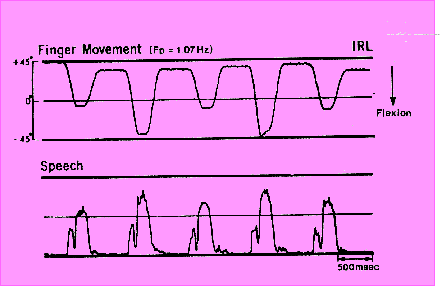Instructions to subject:
Alternate extent of finger flexions
Repeat "stock" without varying stress

Repeat "stock" with alternating stress
Oscillate finger without varying extent

Speech is an inherently rhythmic activity.
Rhythm of speech involves patterning of strong "beats" that coincide with some syllables. Roughly speaking, stressed syllables are those that coincide with the beat.
The rhythm of talking may be synchronized with (entrained to) other biological rhythms (breathing, walking, etc.)
Synchronization of speech and finger flexion (Kelso, Tuller, and Harris, 1983):
Instructions to subject:
Alternate extent of finger flexions
Repeat "stock" without varying stressRepeat "stock" with alternating stress
Oscillate finger without varying extent
Stress as linguistic use of rhythm
Languages with (equal) beats on every syllable
If a language has only a regular beat pattern, with every syllable coinciding with a beat, the language is said to not have stress (or to be syllable-timed).
French can be described as such a language.
Languages with alternating beat/non-beat patterns
A beat and its associated non-beat syllables constitute a foot. (In English, a foot is a stressed syllable followed by any unstressed ones).
Feet may differ in "strength" from one another, and form a more global beat pattern:
Beat structure can be hierarchical.
In general in such languages, we may ask which syllables may coincide with the strong beats and which are aligned with the weak.
Alignment Possibilities
(1) Word Alignment
Stress is fixed with respect to word position.
word-initial: Czech, Finnish
word-penultimate: Polish, Zulu
Stress functions to demarcate words in speech
This may be true even in languages in which alignment is not completely regular.
Evidence that English speakers (even young infants learning English) intially parse running speech so as to posit that each stressed syllable begins a new word.
(2) Contrastive stress
Words may contrast with one to another as to which syllable is aligned with beat.
English: óbject vs. objéct
Russian: múka 'torture', muká 'flour'
(3) Alignment to syllable weight.
Word position of the beat may be predictable as a function of syllable weight.
"Heavy" syllables attract stress.
Heavy syllables have long or tense vowels, or are closed by consonants.
In Engish nouns, stress is antepenultimate, unless the penultimate syllable is heavy.
|
Stress |
|
|
|
|
|
|
|
English: |
America |
agenda |
|
|
catapult |
ellipsis |
|
|
genesis |
arthritis |
|
|
|
|
|
Latin |
refecit |
refe:cit |
|
|
|
refectus |
Degrees of Stress?
If a given word has more than one stress (or foot), are they all equal, or some feet stronger than others?
No complete agreement.
Ladefoged suggests that words are not marked as to which foot is stronger, but rather this increased strength is due to (independent) other factors.
Degree of composed of:
- full vs. reduced vowel
- stressed vs. unstressed syllables
- (pitch-)accented vs. unaccented: last stressed syllable in phrase receives tonic accent.
Stress in context
Not every "potentially" stressed syllable will always bear a beat. This can vary as a function of rate of speech, for example.
Test for stress by tapping.
únder
but: I put the kéy under the dóor.
yóunger, wánted, chócolate
but: Máry's younger bróther wanted fífty chocolate péanuts.
Physical differences between stressed and unstressed syllables
(tendencies, not always true)